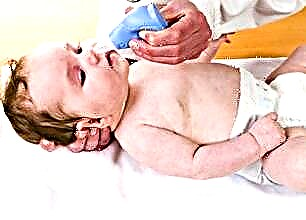One of the leading manifestations of the common cold is the common cold. It brings a lot of trouble - it interferes with normal conversation and sleep. In addition, appetite decreases, there is no sense of smell, and the voice becomes nasal. Not everyone understands that the causes of the common cold can be non-infectious, and are represented by concomitant pathology or allergens.
 Inflammatory lesions of the mucous membrane can proceed in an acute or chronic form, on which the symptom complex and the effectiveness of therapy depend. Rhinitis goes through several stages:
Inflammatory lesions of the mucous membrane can proceed in an acute or chronic form, on which the symptom complex and the effectiveness of therapy depend. Rhinitis goes through several stages:
- reflex - characterized by spasm of blood vessels against the background of exposure to the cold factor or dust. Clinically, this is manifested by dryness, itching, a burning sensation in the nose, sneezing and shortness of breath;
- catarrhal - manifested by edema, hyperemia of the mucous membrane, as well as increased secretion. Symptoms appear due to the expansion of blood vessels and the development of an inflammatory reaction against the background of the release of toxins by pathogenic microorganisms. Discharge from the nose - mucous, watery, breathing is difficult, lacrimation and deterioration of smell are possible;
- the snot becomes thicker, their volume gradually decreases, and the inflammation regresses. The duration of rhinitis is 10 days, however, with the addition of a bacterial infection or the development of complications (sinusitis), the duration of the disease can be up to a month. In this case, the volume of secretions increases, they acquire a greenish tint, become thick and can accumulate in the paranasal sinuses. Symptomatically, a person feels nasal congestion, nasalness, lack of smell, pain in the glabellar, paranasal area, forehead, and bridge of the nose. Fever can reach 39 degrees, the person does not sleep well and is very weak.
Advanced rhinitis leads to sinusitis, otitis media, and the spread of infection to the brain tissue.
Causes of the common cold
Why does snot appear? Damage to the nasal mucosa, cilia dysfunction and hypersecretion result in a runny nose. Its reasons:
- viral agents (rhinoviruses, adenoviruses, influenza);
- bacteria (streptococci, staphylococci);
 fungi (quite rare) - candida, mold;
fungi (quite rare) - candida, mold;- hypothermia. This applies to prolonged stay in a cold, damp room, getting wet in the rain or freezing in the cold;
- allergic factors (food, medicine, wool, hygiene products, household chemicals, perfume or pollen);
- violation of nervous regulation;
- endocrine pathology;
- atrophic processes in the nasal mucosa, provoked by prolonged inhalation of dry, polluted air or chronic rhinitis. This group of reasons also includes the uncontrolled use of nasal drops with a vasoconstrictor effect (Lazorin, Evkazolin). Snot may appear due to the exceeding of the terms of use of these drugs;
- chemicals or increased dust content in the air (hazardous production);
- curvature of the septum disrupts normal nasal breathing, which predisposes the activation of opportunistic microorganisms;
- climatic factor (inhalation of cold air, exposure to the sun);
- adenoids. They can become a source of chronic infection, manifested by frequent adenoiditis;
- chronic sinusitis;
- weakened immunity with severe infections (tuberculosis, HIV) or systemic diseases (rheumatoid arthritis, diabetes).
Vasomotor rhinitis
The appearance of vasomotor rhinitis is caused by a dysregulation of the vascular wall, due to which the vessels cannot adequately respond to the influence of provoking factors. Symptoms of the disease can appear against the background of complete well-being, reducing the quality of a person's life. Pathology is not a serious illness, but it negatively affects the general well-being.
Over time, the nasal mucosa undergoes some changes, predisposing the appearance of a runny nose. There are many reasons for the development of vasomotor rhinitis, here are a few of them:
- medicines. Often, when snot appears, people use vasoconstrictor drugs in the form of nasal drops or spray. As a result of their frequent use, addiction develops, which requires an increase in dosage. Changing medicines allows you to achieve the desired effect, but not for long. Against the background of the use of vasoconstrictor agents, the blood vessel wall loses its ability to independently respond to external factors and change its tone. You also need to be careful with antihypertensive, anti-inflammatory drugs, antidepressants and medications that increase male sexual activity;
- endocrine diseases, which are accompanied by a violation of hormonal levels. This group of reasons should include the period of pregnancy and adolescence, when physiological hormonal changes occur;
- vegetative-vascular dystonia, caused by a violation of the regulation of vascular tone, due to which the whole body suffers;
- additional formations in the paranasal cavities. This applies to various growths of allergic, benign or malignant origin. Constant irritation of the mucous membrane provokes increased secretion. To cope with the problem, the question of performing a surgical intervention is being decided.
An increase in symptoms is observed with hypothermia, smoking, stress, or inhalation of pungent odors.
- work in production associated with polluted air, dampness or strong odors;
- cold factor. Rhinorrhea and sneezing appear after contact with cold (hypothermia of the hands, feet, the influence of a draft). Similar symptoms can appear with prolonged exposure to the open rays of the sun.
Separately, the idiopathic form is distinguished when the cause cannot be established. Sometimes it happens that several provoking factors are simultaneously influencing, which also complicates the diagnosis.
When the vascular tone does not change, blood stagnation occurs in the vessels, the permeability of the wall increases, and the liquid part of the blood sweats into the tissue. Thus, edema is formed and secretion is enhanced.
Symptomatic vasomotor rhinitis can manifest itself in varying degrees of severity. For the first time, signs can be recorded in childhood, but the appearance of symptoms at the age of 20 is possible. Of the clinical signs, it is worth highlighting:
- nasal congestion. It is characterized by a lack of breathing through one nasal passage, which is most often noted during sleep. When a person sleeps on their side, congestion appears in the nasal passage below;
- profuse mucous discharge;
- frequent sneezing, sometimes paroxysmal;
- itchy nose;
- a feeling of mucus flowing down the nasopharynx;
- swelling of the nasal mucosa;
- headaches, dizziness, poor sleep, decreased appetite and fatigue as a result of difficulty in nasal breathing.
Allergic rhinitis
Allergic rhinitis is often diagnosed, the causes of which are hidden in the increased sensitivity of immunity to a certain allergen of external or internal origin. The most common "provocateurs" are:
- chemical substances;
- pollen;
- protein compounds;
- microorganisms;
- aromatic agents;
- cold or heat factor;
- medicines;
- Food;
- vaccines;
- acne mites, mold and fungal spores.

Seasonal rhinitis is a pollen allergy that mainly affects the respiratory tract and eyes.
The development of the disease may be due to a burdened heredity, weakened immunity, or frequent colds. Symptoms are rhinitis and conjunctivitis, but in advanced cases, bronchial asthma develops.
The person is also worried about:
- severe itching;
- repeated sneezing;
- profuse, mucous discharge from the nose;
- labored breathing;
- lacrimation;
- irritability;
- malaise;
- aches;
- insomnia.
Clinical signs appear during flowering of plants (late spring, summer, early autumn). Attacks can be triggered by sunlight, draft, or freezing. Sometimes coughing, sore throat and voice hoarseness can disturb.
A persistent allergic rhinitis is observed upon contact with a certain factor throughout the year. Symptoms bother for a long time, often several months.
Neurovegetative rhinitis
This form of pathology is not characterized by seasonality, therefore, symptoms can appear at any time of the year. The cause of rhinitis may lie in high air pollution, contact with chemicals, or dysfunction of the nervous system.
Often, pathology occurs against the background of osteochondrosis of the cervical spine. In the interictal period, a person notices a slight nasal congestion and scanty mucous discharge. With an exacerbation, severe itching, cephalalgia and malaise appear. The duration of the attack is 2-3 hours. At night, nasal congestion is constant, due to the predominance of the parasympathetic action of the nervous system.
Infectious rhinitis
Why does a runny nose appear? Most cases of rhinitis are infectious. This can be either a "new" infection of the body, or an exacerbation of a chronic infection. A runny nose that appears is a consequence of the intensive multiplication of pathogenic microorganisms and the increased production of toxic substances.
 During nasal breathing, the mucous membrane collides with viral agents, which, with a decrease in local protection, settle on its surface and cause inflammation.
During nasal breathing, the mucous membrane collides with viral agents, which, with a decrease in local protection, settle on its surface and cause inflammation.
Against the background of a viral disease, the risk of a bacterial infection increases, which complicates the course of rhinitis. Signs of bacterial inflammation are:
- febrile hyperthermia, which persists as long as bacteria are present. To eliminate them, it is necessary to take antibacterial drugs or rinse the infectious focus with antiseptic solutions;
- discharge from the nose of a greenish tint. Gradually, their consistency changes to a thicker one;
- headache (forehead, bridge of the nose, eyebrows, paranasal region). The appearance of pain syndrome is due to the accumulation of viscous pus and increased intoxication;
- decreased appetite;
- poor sleep;
- weakness;
- irritability.
If the infection is not completely eliminated, the inflammation becomes chronic. It is quite difficult to cope with it, therefore, it is not advisable to allow chronization.
Prevention of rhinitis
You can reduce the frequency of the occurrence of a runny nose with the help of simple rules. They allow you to strengthen the immune system and prevent the development of complications. Colds and rhinitis in this case proceed quickly and in a milder form. Recommendations relate to healthy eating, sports and good rest. You need to dose physical activity, devote enough time to sleep and hobbies that bring joy. In the presence of chronic foci of infection (tonsillitis, sinusitis), the activity of microbes should be monitored by regular examinations.
As for spa therapy, it is the best way to cheer yourself up and improve your body.

 fungi (quite rare) - candida, mold;
fungi (quite rare) - candida, mold;

